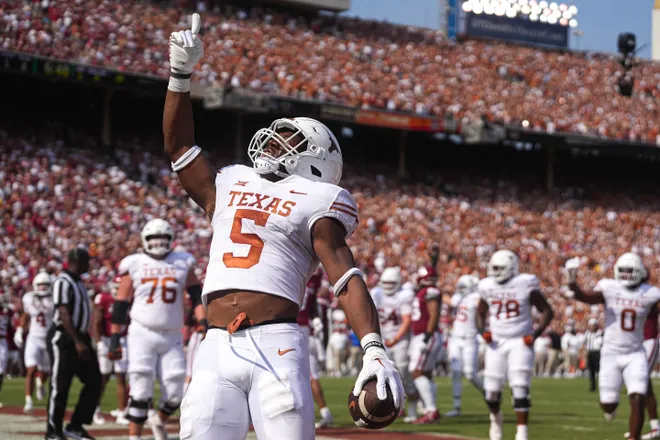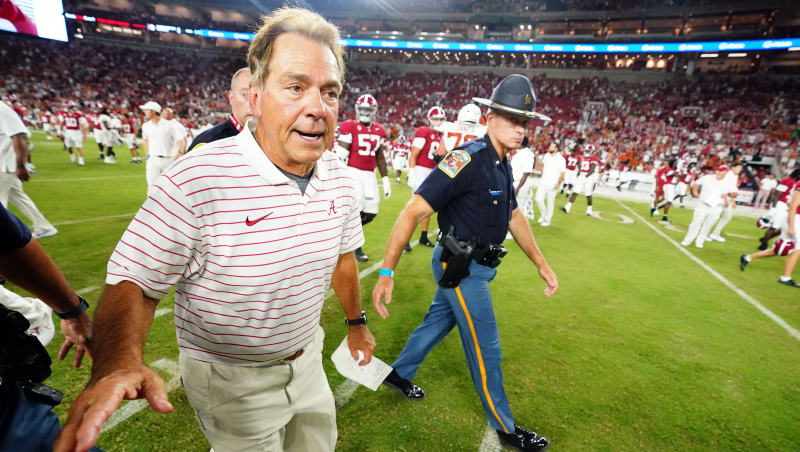It's Texas-OU's last Red River Rivalry in the Big 12. This split is a sad one.
Over the last calendar year, nobody in college football has been a bigger winner than the Big 12, given the guillotine that was hanging over its neck at every turn.
From legitimate questions about whether the league would survive to securing a television deal that stabilized its future for the rest of the decade to winning a turf war that more or less destroyed the Pac-12, there was zero irony in the gleeful proclamation from commissioner Brett Yormark that his league is “cemented at No. 3.”
But Saturday’s final Red River Rivalry between Oklahoma and Texas as Big 12 members should be a sad day for the league. Because unlike all the celebratory rhetoric that has accompanied the league’s recent realignment moves, this Oklahoma-Texas game will underscore what has largely been forgotten: The Big 12’s future as a nationally relevant football entity is not going to be as robust as its past.
The next version of the Big 12 is going to have Utah-BYU, Arizona-Arizona State, Baylor-TCU and Kansas-Kansas State, all good rivalries that might be important games in a given year.
But Texas-Oklahoma has been the foundation of the Big 12’s entire existence regardless of whether those programs were contending for national titles or plotting to get rid of their coaches. And in a few months, it will belong to the SEC.

Sure, the Big 12 is going to survive thanks to Yormark’s aggressiveness in jumping ahead of the Pac-12 to get a television deal done amidst an uncertain financial environment for ESPN and other cable partners. The expansion of the College Football Playoff to 12 teams will ensure that the Big 12 champion has a spot in the postseason. And Yormark’s contention that the Big 12 is No. 3, ahead of the ACC in the pecking order, may eventually prove to be correct. .
But what is that actually going to be worth competitively when Texas and Oklahoma leave? The picture may be bleak.
Outside of those two, the Big 12 has not been a particularly good conference this season. Oklahoma State, Baylor and Iowa State — three programs that had star turns in recent years — have all gone in the wrong direction. TCU at 3-2 is struggling to back up its charmed run to the national championship game. The three newcomers from the American Athletic Conference are a combined 0-6 in conference play. Outside of Texas and Oklahoma, Kansas State is the only other Big 12 team among the top-25 in the Sagarin ratings at No. 16.
When the Big 12 adds four more schools next season from the Pac-12 to complete its reformation, its best hope will be that Deion Sanders has Colorado rocking and rolling in Year 2 and that Utah can maintain the high standard it achieved by recruiting much of its roster in California and the Southwest.
Things can change from year to year in college football, but make no mistake: As beleaguered as the Big 12’s history has been, it will be a worse football league in 2024 than it has ever been because it doesn’t have Texas and Oklahoma.
Right before this season began, Yormark created some headlines while speaking at a Texas Tech fan event when he told coach Joey Maguire he better “take care of business” against the Longhorns when they play the day after Thanksgiving. Yormark brushed it off as playing to the crowd and having a good time, but there’s a little bit of truth in every joke. Nobody in the Big 12 this year wants to see Texas and Oklahoma go out on top.
And this weekend’s game makes it plain for everyone to see: The Big 12 is a winner of conference realignment because it survived. But in the big picture, it is losing something it will never get back.
The irony, though, is that Texas and Oklahoma are losing something, too. If college sports is heading toward an inevitable consolidation of the biggest brands into one or two mega-conferences, they have found the right landing spot in the SEC. But they will never again have a setup as favorable as now where the biggest obstacle toward greatness is each other.
When Texas and Oklahoma shocked the world in 2021 by announcing their intention to join the SEC, it was a highly cynical move. The people at both schools can say whatever they want about their admiration for and cultural fit within the SEC, but it’s hard to imagine it would have happened if Texas had not spent the last decade as the sport’s biggest under-performer.
Were the Longhorns averaging a mediocre seven wins a year between 2010-2020 because of the Big 12 or because Mack Brown lost his edge after a long run of success and the next two coaches they brought on board were simply in over their heads? Were the recruiting classes disappointing because top prospects preferred to play in the SEC or because the program had not been optimized by someone like current coach Steve Sarkisian, whose track record as a recruiter was unimpeachable? If name, image and likeness rights had been granted to athletes five years earlier, would Texas have needed the SEC cachet to jump-start a recruiting operation that is now humming at the highest level?
These are impossible questions to answer, but there’s no doubt that concerns over losing touch with its immediate recruiting competitors like Texas A&M prompted Texas to make a drastic move, which in turn brought Oklahoma into the fray because the Sooners knew that a Big 12 without Texas was a Big 12 they didn’t want to be in anymore.
But ironically, this last dance in the Big 12 illustrates why that league was so good for both of them. Texas may well be the best team in the country right now, and if the Longhorns win Saturday they have a relatively clear path to 12-0 and a likely Playoff berth. The same goes for the Sooners, who struggled last season in Brent Venables’ coaching debut but have quickly rebounded to 5-0.
Both programs have traded a league where they have all the advantages to be part of a new college football paradigm. The Red River Rivalry is always going to be big, but it can’t be as defining to a league and a college football season as it will be on Saturday.
After this game, the Big 12 will say thanks for the memories and go back to touting its new lineup and its stable future. Texas and Oklahoma will surely do the same.
But this separation will be a sad one. Dysfunctional as the Big 12 may have been for much of its history, Saturday’s game will show what the value of the league has been with Texas and Oklahoma in it.
At some point, both sides are going to miss that.

Disclaimer: The copyright of this article belongs to the original author. Reposting this article is solely for the purpose of information dissemination and does not constitute any investment advice. If there is any infringement, please contact us immediately. We will make corrections or deletions as necessary. Thank you.







